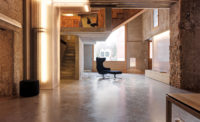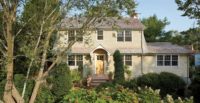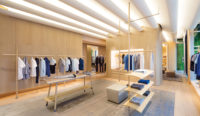The mandate was clear: design a house that offers privacy from the outside world but opens up to gardens and terraces within its confines. The solution was a familiar one for the setting in Andalusian Spain, where inward-facing patio houses speak of a Moorish heritage. However, in conceiving a vacation retreat for a family of four in Marbella, on the palmy Costa del Sol, Swiss architect Gus W'stemann has avoided the arcaded courtyards and red-tile roofs typical of the region. He has kept the general idea, but emphasizes the abstracted masses and voids seen in his other work, such as the muscular concrete residence Two Verandas in Zurich. The client, a European businessman, had been coming to the resort for 20 years to enjoy golf and spend time with friends and family. When he decided to build a new home there, he was drawn to the strong geometries and complex play of light and shadow in W'stemann's architecture.
While Marbella's sunny weather, sandy Mediterranean beaches, and breaking surf account for its popularity, the picturesque village had fewer than 1,000 residents right after World War II. During the 1960s and '70s, it became the haven for the so-called jet set, a migratory social flock of aristocrats, showbiz people, and rich political exiles. Attracting such 'beautiful people' as Prince Alfonso von Hohenlohe, Sean Connery, and former Cuban dictator Fugencio Batista y Zaldivar, Marbella grew as others followed: today the population is over 140,000. It is good to be able to withdraw behind garden walls.
W'stemann's plan recalls those that Mies van der Rohe developed in his elegant linear-court house projects of the 1930s and '40s'only here, as the architect puts it, 'much of the program for the house is hidden on the periphery.' Its concrete frame with white plastered masonry infill walls gives it an implacable and impenetrable solidity. Following the outline of the property'a parallelogram in a compact residential area'you might say the 6,200-square-foot house evokes, on a small scale, fortresses such as the nearby 10th-century Moorish Sohail Castle.
The neighbors at first didn't see this historic connection. Since it diverged from the Spanish Mediterranean or classical-style vocabulary typical of Marbella's villas, they asked the client if it was going to be a hotel or a department store. As the owner tells it, they even expressed concern to the local government that the design represented a violation of the residential zoning. No, it was simply a house.
Stepping through the protective entrance behind the thick walls enclosing the site, you are surprised to find yourself in a light-filled living and dining area contained in a glazed bar. It extends the width of the house, stretching from the entrance vestibule on the north to a minimal kitchen on the south wall'so minimal, in fact, that it is hard to find the stove (concealed by a movable counter) or other culinary appurtenances.
Long sliding glass walls open the indoor living spaces to a patio and a small pond immediately to the east, and to a grassy lawn and swimming pool to the west. Looking in this direction, where the house's receding columns and beams frame vistas and define the various interior and exterior areas, you can catch a glimpse of the Sierra Blanca Mountains. As the spaces unfold, boundaries blur between inside and out. 'We just move the furniture outdoors when it gets warmer,' says the client on a 65-degree winter's day. Not all of it moves, however: W'stemann has created nooks with built-in benches and podiums of masonry covered with a smooth cementitious coating'as integrated with the architecture as built-ins are in the habitations of Le Corbusier.
Leaving the living area and walking west to the lawn and garden, you pass through an open court, a spatial void that is the center of the house. Bound on the four sides of the second level by expansive grills of slender precast-concrete brick, the court seems enclosed by modern-day Moorish mashrabiyas, which filter light into the corridors leading to the bedrooms, library, and media room. Where the upper bedroom wing overlooks the lawn, an L-shaped pool, and a lemon grove, W'stemann has carved deep niches, much like the syncopated crenellations of a medieval fort, to provide secluded sunporches for the occupants and guests.
In boiling down the elements of both historic and modern motifs to their essentials, W'stemann avoids obvious replications of any particular style. His unremitting approach to clean details reveals his architectural training at Zurich's rigorous Swiss Federal Institute of Technology. Yet the fact that he has offices in Barcelona as well as Zurich explains his more casual Mediterranean sensibility and underlies the house's subtle combination of control and la buena vida.
Size: 6,200 square feet
Construction Cost: withheld
Completion date: July 2014
PeopleClient: Owner: Architect Escullera de Poble Nou, 163 Personnel in architect's firm who should receive special credit: Engineers: Consultant(s): General contractor: Photographer(s): |
ProductsStructural system Exterior cladding Precast concrete: White 250x250mm precast concrete pieces screen walling, SAS C-260 Roofing Windows Glazing Doors Wood doors: interior doors of DM varnished in white, hidden hinges Sliding doors: Panoramah sliding doors Hardware Security devices: FERMAX video monitors Interior finishes Paints and stains: walls finished with smooth plastic painting ACRITON / in wet zones walls finished in microcement in white Furnishings Lighting Energy |















Post a comment to this article
Report Abusive Comment